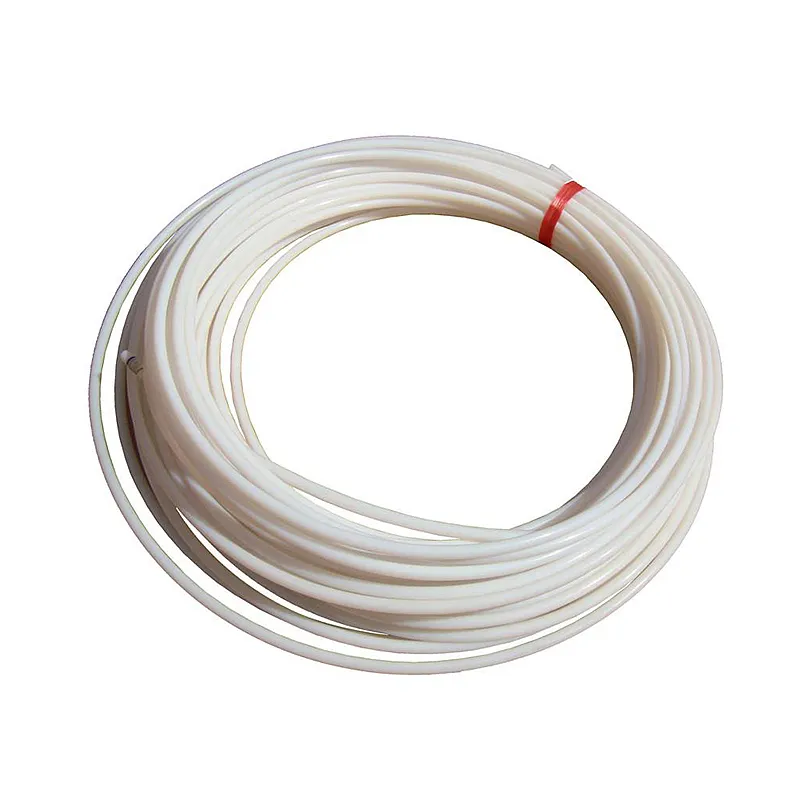El tubo de PTFE (ptfe), también conocido como tubo de teflón, es un tubo de plástico hecho de resina de ptfe. Es conocido por sus excelentes propiedades como resistencia a altas temperaturas, inercia química, superficies antiadherentes y bajo coeficiente de fricción.
1.Resistencia a la temperatura: PTFE tubing can withstand temperatures ranging from -100°C to +260°C, making it suitable for extreme environments.
2.Compatibilidad química: It is highly resistant to most chemicals and solutions, except for sodium, potassium, and lithium, which can affect its chemical stability.
3.Superficie no pegajosa: The low surface tension of PTFE prevents adhesion of any material, facilitating fluid flow and eliminating media buildup.
4.Baja fricción: With the lowest friction coefficient among polymers, PTFE tubing is ideal for applications requiring lubrication.
5.Biocompatibilidad: It is safe for use in medical applications due to its non-toxic and non-reactive properties.

1.Tubo de pared estándar: Suitable for general-purpose applications.
2.Tubería de aceite de pared gruesa: Offers additional mechanical strength and pressure resistance.
3.Tubo de paredes delgadas: Used in applications where space is limited.
4.Tubo de cinta de película: Ideal for thin-walled liners requiring high flexibility.
5.Tubo de extrusión de compuertas: Preferred for larger-bore delivery systems or devices needing high tensile strength.
6.AWG (american Wire gauge); Tubo de aceite segmentado: Designed for electrical insulation applications, with varying wall thicknesses.
1.Tratamiento de fluidos: Used in systems handling chemicals, corrosive materials, and other fluids.
2.Dispositivos médicos: Ideal for catheters, introducer sheaths, and other medical applications due to its biocompatibility and low friction.
3.Aislamiento eléctrico: Suitable for wire and cable insulation, circuit boards, and other electrical components.
4.Industria de semiconductores: Utilized in processes requiring high purity and chemical resistance.
5.Alimentos y bebidas: Safe for use in food processing and handling due to its non-toxic properties.
1.Preparación de materias primas: High-quality PTFE resin is selected and processed into a form suitable for extrusion.
2.Exprimir: The resin is heated to a semi-liquid state and forced through a die to create the desired tubing shape and size.
3.Enfriamiento y sinterización: The tubing is rapidly cooled and then sintered in an oven to enhance its mechanical properties.
4.Control e inspección de calidad: Rigorous testing ensures the tubing meets specified dimensions and properties.
5.Operación auxiliar: May include cutting to length, flaring, or adding fittings as per the final application requirements.
1.Limpieza regular: Use clean water or mild detergents to clean the tubing surface. Avoid using abrasive tools or chemicals that could damage the tubing.
2.Inspección: Regularly inspect the tubing for any signs of wear, deformation, or damage. Replace damaged tubing promptly.
3.Controlar la calidad de los medios: Ensure the media flowing through the tubing is free of excessive impurities to prevent clogging.
4.Almacenamiento: Store PTFE tubing in a dry, ventilated, and light-protected environment when not in use.
La singularidad del PTFE se debe a su estructura química. Los potentes enlaces de carbono y flúor le dan un alto grado de resistencia a la erosión química, mientras que la ausencia de enlaces intermoleculares de hidrógeno ayuda a sus propiedades de baja fricción y no pegajosidad.
Tanto el PTFE como el PFA (grupo perfluoroalquilo) son Polímeros fluorados con propiedades similares, pero hay algunas diferencias clave:
1.Resistencia a la temperatura: PTFE has a higher temperature resistance than PFA.
2.Procesabilidad del derretimiento: PFA can be melt-processed, making it easier to fabricate into complex shapes, whereas PTFE is processed through sintering.
Transparencia: PFA is transparent, while PTFE is usually opaque.
When selecting PTFE tubing, consider factors such as:
1.Condiciones de solicitud: Choose tubing based on the specific needs of your application, such as temperature range, chemical compatibility, and pressure rating.
2.Espesor de la pared: Select the appropriate wall thickness for your application, balancing mechanical strength and flexibility.
3.Longitud y personalización: Determine the required length and whether customization, such as color or striped tubing for identification, is needed.
4.Reputación del proveedor: Choose a reputable supplier known for quality and reliability.
¿P: ¿ es seguro el tubo de PTFE en aplicaciones de alimentos y bebidas?
A: Yes, PTFE tubing is non-toxic and inert, making it safe for use in food and beverage processing.
¿P: ¿ puede el tubo de PTFE soportar altas temperaturas?
A: Yes, PTFE tubing can withstand temperatures up to 260°C, making it suitable for extreme environments.
¿P: ¿ cómo se fabrican los tubos de ptfe?
A: PTFE tubing is manufactured through a process involving raw material preparation, extrusion, cooling, sintering, and quality control.
En resumen, el tubo de PTFE tiene una amplia gama de ventajas y es adecuado para una variedad de aplicaciones. Conocer su rendimiento, tipo y requisitos de mantenimiento le ayudará a tomar decisiones inteligentes a la hora de elegir y usar tuberías de ptfe.